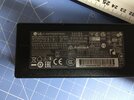Hello,
My LG widescreen display has a power cable a bit like a laptops. Jack in back of display, to box unit, and then a clover head plug to 10amp 3 pin plug. It's too short for me. I like to buy a 2-3m version of the last bit - clover head plug to 10amp 3 pin plug.
Can anyone send me a link where I can buy one of these online?
Thanks, photos below:
My LG widescreen display has a power cable a bit like a laptops. Jack in back of display, to box unit, and then a clover head plug to 10amp 3 pin plug. It's too short for me. I like to buy a 2-3m version of the last bit - clover head plug to 10amp 3 pin plug.
Can anyone send me a link where I can buy one of these online?
Thanks, photos below:






